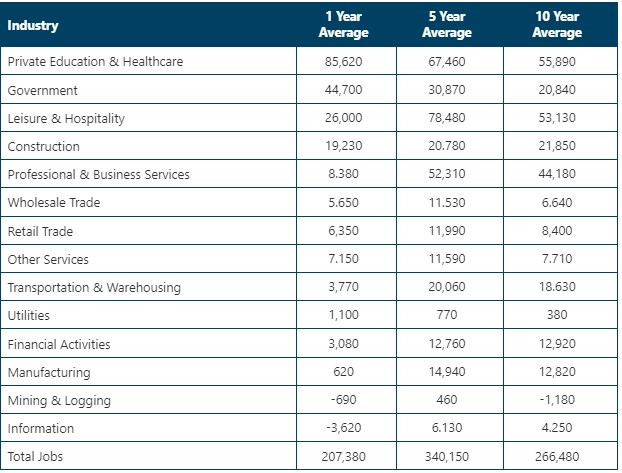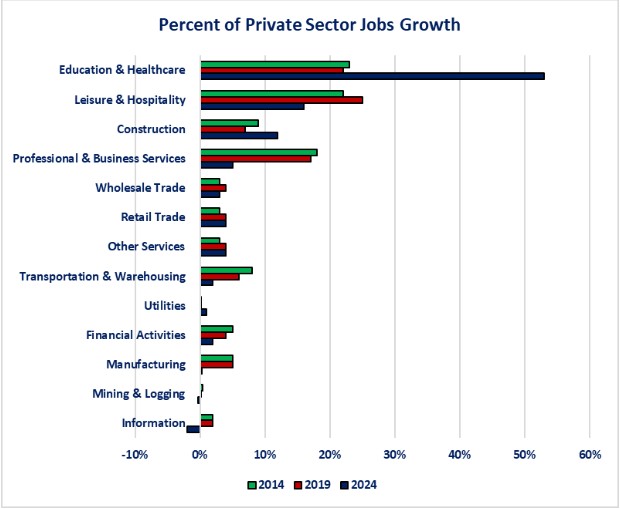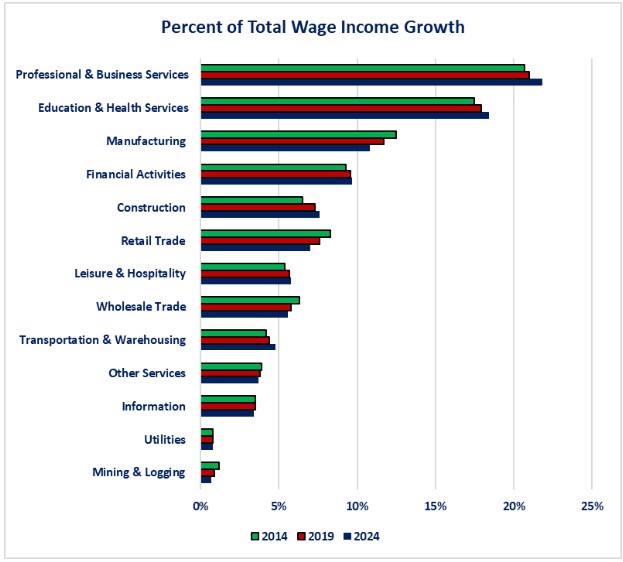Enjoy the experience of our restaurant.
Register to know our latest news.
Lorem ipsum dolor sit amet, consectetur adipiscing elit, sed do eiusmod tempor incididunt.
Lorem ipsum dolor sit amet, consectetur adipiscing elit, sed do eiusmod tempor incididunt.
Lorem ipsum dolor sit amet, consectetur adipiscing elit, sed do eiusmod tempor incididunt.
Lorem ipsum dolor sit amet, consectetur adipiscing elit, sed do eiusmod tempor incididunt.
Steve Scranton
SVP, Chief Investment Officer and Economist Content Authenticity Statement: The Economic Perspectives newsletter is comprised entirely of the expertise, thoughts, perspectives and opinions of the author with no use of generative AI. Data is sourced from the original providers (typically government agencies) and analyzed by the author. Perspectives Last Friday, Federal Reserve Chairman Powell gave a speech and indicated that the time had come to begin lowering interest rates. He cited weakness in the labor markets as the reason to do this. For over two years the Federal Reserve's sole focus was taming inflation. It appears that it now feels that the focus should be on jobs. Today's Perspectives examines jobs and wages. I am adopting a new format for the Perspective section. Based on conversations and feedback, I have been reminded that different viewers have different preferences. Some desire a short “Two Minute Sound Bite”, others prefer a “Short Book” with a few details, while other like a full-blown “Novel” with all of the details, tables and graphs. As a result, starting today: Two Minute Sound Bite The slower-than-expected jobs growth in July caught the Federal Reserve's attention and the downward revision of 810,000 fewer jobs than originally reported between April 2023 and March 2024 appears to have spooked the Federal Reserve. Even though jobs are growing, the pace is clearly slowing. An area of concern is that, over the past ten years, jobs growth has been highly concentrated in three to four sectors and has become even more concentrated over the past twelve months. For the past year, the top three industry sectors (Education & Healthcare, Government and Leisure & Hospitality) accounted for 75% of total jobs growth. The problem is those industries are not the leaders from a wage perspective. From a wage perspective, those top three industries for jobs growth only accounted for 33% of wage growth. If we want to monitor for potential changes in consumer spending, we should watch for changes in jobs growth for the top three industries for wages. Next Friday's jobs report will be the key deciding factor for the Federal Reserve's interest rate decision in September. Inflation remains stubbornly around the 2.6% level, so a weak jobs report is needed to justify an interest rate reduction. Summary Observations Total Jobs Growth In order to get a more realistic picture, I have excluded the distortion in jobs growth due to the pandemic crisis. This means that I have excluded data from March 2020 through September 2020 due to the huge swings in the numbers. By October 2020, those distortion had dissipated. Industry Sectors as a Percent of Total Jobs Growth Since the BLS does not provide average weekly earnings details for Government jobs, I am showing the same graph as above but as a percent of total Private jobs. This will allow comparison to wage details. The concentration of jobs growth is even bigger when examining private sector jobs growth. The top three industries (Education & Healthcare, Leisure & Hospitality, Construction) accounted for 81% of total jobs growth as of July 2024. The top three (Education & Healthcare, Leisure & Hospitality, Professional & Business Services) accounted for 61% as of July 2019 and 63% as of July 2014. The top three industries for jobs growth as of July 2024 may have accounted for 81% of private sector jobs growth but they only accounted for 33% of total wage growth. This raises the question as to whether there were distortions that were not fully adjusted for with the seasonal adjustment factors that are used. It will be interesting to see if this was a one -time distortion that corrects itself with the August data that will be released next week. The financial markets (and the Federal Reserve?) are clearly not prepared for the possibility that July's numbers were an aberration if that proves to be the case! One of the problems with the concentration in jobs growth-especially as of July 2024-is that it is lower paying jobs that are seeing the most growth. Education & Healthcare ranks 10 out of 13 for average weekly earnings as of July 2024. Leisure & Hospitality ranks 13 out of 13. Construction ranks 8 out of 13. Utilities ranks #1 but only contributed 1% to total jobs growth. Information ranks #2 and lost jobs. Mining & Logging ranks #3 and lost jobs. The Federal Reserve has two mandates in its charter. Full employment Stable inflation For over two years the Federal Reserve has focused solely on inflation because it was well above its 2% target and jobs growth was strong. With the weak jobs report for July and the major downward revision to April 2023 through March 2024 data, the focus has now shifted. The most July minutes from the Federal Reserve reflected the fact that it is now focusing on both the health of jobs growth as well as inflation The speech given by Chairman Powell last Friday indicates that the Federal Reserve may now have moved to focusing more heavily on jobs growth. As a result, next Friday's jobs report has gained far more importance than previous reports. We will gain a better understanding as to whether the Federal Reserve is solely focused on jobs if the jobs report is weak and the Federal Reserve cuts interest rates. The inflation data has remained stubbornly around the 2.6% level so if the Federal Reserve was still solely focused on inflation, an interest rate cut would be questionable. If a rate reduction occurs at the September policy committee meeting, it will show that the Federal Reserve has now shifted its focus to jobs. Data Time Period Being Reported Current Previous Comments 8/26/24 Durable Goods Orders Monthly Change July +9.9% -6.9% The surge was all due to a surge in Transportation orders. Core Durable Goods Orders Monthly Change July -0.2% +0.1% Orders fell once the Transportation sector was factored out. 8/27/28 FHFA Home Price Index Year-Over-Year Change June +5.1% +5.9% Home prices continue to grow but at a slightly slower pace. S&P Case Schiller Home Price Index June +6.5% +6.9% Same trend as the FHFA index. Consumer Confidence August 103.3 101.9 Lower interest rates and rising financial markets helped boost confidence. Richmond Federal Reserve Manufacturing Activity Index August -19 -17 Activity fell further in August. Richmond Federal Reserve Service Sector Activity Index August -11 +5 Activity in the service sector fell into contraction. Dallas Federal Reserve Service Sector Activity Index August 8.7 7.7 Activity improved slightly. 8/28/24 MBA Mortgage Applications Weekly Change 8/23/24 +0.5% -10.1% Activity picked up slightly as mortgage rates remained stable. 8/23/24 +1.0% -5.0% Buyer activity continues to remain muted as home prices have not come down. 8/23/24 -0.1% -15.0% With little movement in rates, activity was basically unchanged. 8/29/24 Initial Jobless Claims Weekly Change 8/24/24 231,000 236,250 Initial claims fell 5.250. Continuing Jobless Claims Weekly Change 8/17/23 1,868,000 1,855,000 Continuing claims rose by 13,000. Real Gross Domestic Product-First Revision 2nd Quarter 3.0% 1.4% 2nd quarter was revised from the original estimate of 2.8% to 3.0%. An upward revision in consumer spending was the primary reason for the upward revision. Pending Home Sales Monthly Change July -5.5% +4.8% Buyers continue to be resistant to the high prices for homes. 8/30/24 PCE Price Index Monthly Change July +0.2% +0.1% This is not the direction that the Federal Reserve desires. PCE Price Index Year-Over-Year Change July +2.5% +2.5% No progress from last month. Core PCE Price Index Monthly Change July +0.2% +0.2% Once again, this is not the results the Federal Reserve desires. Core PCE Price Index Year-Over-Year Change July +2.6% +2.6% No progress from the core number either. Personal Income Monthly Change July +0.3% +0.2% Consumers experienced an increase in their personal income. Personal Income Year-Over-Year Change Jully +4.5% +4.4% Same results for the year-over-year number. Real Disposable Personal Spending Monthly Change July +0.1% +0.1% After inflation and taxes, personal income barely rose. Real Disposable Personal Spending Year-Over-Year Change July +1.1% +1.0% After income and taxes, the year-over-year increase was far smaller than the headline number. Personal Spending Monthly Change July +0.5% +0.3% Consumers ramped up their spending in July. Personal Spending Year-Over-Year Change July +5.3% +5.4% On a year-over-year basis, spending slowed slightly. Real Personal Spending Monthly Change July +0.4% +0.2% Consumers continue to spend at a faster pace than their growth in income. Real Personal Spending Year-Over-Year Change July +2.7% +2.8% Same story for spending after inflation. Real spending is growing at more than double the pace of real income growth. University of Michigan Consumer Sentiment Index August 67.9 66.4 The increase was solely due to an increase in consumers outlook for the future. August 61.8 62.7 Consumers continue to become less confident in their current conditions. August 72.1 68.8 Even though they are gloomy about their current conditions, they are optimistic about the future.

Industry Sectors as a Percent of Total Private Jobs Growth

Industry Sectors as a Percent of Total Wage Growth

Closing Thoughts
Economic Data
Lorem Ipsum has been the industry's standard dummy text ever since the 1500s, when an unknown printer took a galley of type and scrambled it to make a type specimen book.
It has survived not only five centuries, but also the leap into electronic typesetting, remaining essentially unchanged.
Lorem Ipsum is simply dummy text of the printing and typesetting industry.
Enjoy our meals. You can click each menu to display more information.